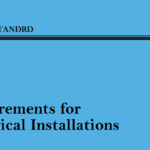BS 7671 18th Edition Maximum Zs
BS7671 2018 + Amendment 2 2022
Max Zs is the maximum permissible values of earth fault loop impedance (Ω), some maximum Zs values are listed in BS 7671, the maximum earth loop impedance values listed in the Zs tables are used to compare against the actual measured earth loop impedance values to ensure compliance with BS 7671.
The Max Zs values also can be found in our Max Zs Values App.
We have received a number of emails regarding the 18th edition max Zs values table 41.3 so we have created this post for the 18th edition maximum Zs values chart. The maximum Zs values for BS7671 18th edition have not changed from the 17th edition wiring regulations to the 18th edition 2018, zs values can be found in table 41.3
The 17th edition of the IET wiring regulations amendment 3 introduced the Cmin (0.95) factor which reduced the old maximum zs values to allow for the fluctuation of the voltage.
The Cmin factor is applied to the voltage to earth (Uo), so if the voltage is 230 the calculation would be 230×0.95 = 218.5 volts.
If you have an old Zs table for a previous version of BS 7671 then see our post on our new Zs Converter to convert old Zs values to the 18th edition values.





